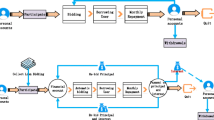Abstract
Online peer-to-peer (P2P) lending service is a new type of financial platforms that enables individuals borrow and lend money directly from one to another. As P2P lending service is rapidly developing, a number of rating systems of borrowers’ creditworthiness are published by different P2P lending companies. However, whether these rating systems could truly reflect the creditworthiness and loan risk of borrowers is unconfirmed. In this paper, we analyzed the differences between credit levels and users’ distribution of CPLP to evaluate if the credit levels can truly reflect the borrowers’ credit. We used soft factors to establish a model that can find borrowers who are likely to default. Further, we proposed some strategies to construct and improve the risk-control of P2P lending platforms according to the result of our research.


Similar content being viewed by others
Notes
Chinese P2P Lending Platform which name is anonymous.
References
Milne A, Parboteeah P (2016) The business models and economics of peer-to-peer lending. Technical report, School of Business and Economics, Loughborough University, UK
Guo Y, Zhou W, Luo C, Liu C, Xiong H (2016) Instance-based credit risk assessment for investment decisions in p2p lending. Eur J Oper Res 249(2):417–426
Freedman S (2008) Dynamic learning and selection:the early years of prosper. Technical report, Prosper.com
Yao FG, Sui X (2015) The research to the influential factors of credit risk in the p2p network loan under the background of internet financial. In: Proceedings of the 22nd international conference on industrial engineering and engineering management 2015
Iyer R, Khwaja AI, Luttmer EFP, Shue K (2009) Screening in new credit markets: can individual lenders infer borrower creditworthiness in peer-to-peer lending? Working paper series. Harvard University, John F. Kennedy School of Government
Black Fischer, Jensen Michael C, Scholes Myron (1972) Studies in the theory of capital markets. Praeger Publishers, New York
Schölkopf B, Williamson RC, Smola A, Shawe-Taylor J, Platt J (1999) Support vector method for novelty detection. In: Proceedings of the 12th international conference on neural information processing systems, NIPS’99. MIT Press, Denver, CO, pp 582–588. http://dl.acm.org/citation.cfm?id=3009657.3009740
Luo C, Xiong H, Zhou W (2011) Enhancing investment decisions in p2p lending: an investor composition perspective. In: Proceedings of the 17th ACM SIGKDD international conference on Knowledge discovery and data mining
Yu L, Cui P, Wang F, Song C, Yang S (2015) From micro to macro: Uncovering and predicting information cascading process with behavioral dynamics. ICDM
Klafft M (2008) Online peer-to-peer lending: a lenders’ perspective. SSRN Electronic Journal
Iyer R, Khwaja AI, Luttmer EFP (2009) Screening in new credit markets: can individual lenders infer borrower creditworthiness in peer-to-peer lending? SSRN Electron J
Li Y, Rakesh V, Reddy CK (2016) Project success prediction in crowdfunding environments. WSDM
Berger SC, Gleisner F (2009) Emergence of financial intermediaries in electronic markets: the case of online p2p lending. Bus Res
Zhang Yizhou, Xiong Yun, Kong Xiangnan, Zhu Yangyong (2016) Netcycle: Collective evolution inference in heterogeneous information networks. In: Proceedings of the 22nd ACM SIGKDD international conference on Knowledge discovery and data mining
Freedman SM, Jin GZ (2008) Do social networks solve information problems for peer-to-peer lending? evidence from prosper.com. SSRN Electron J
Barasinska N, Schaefer D (2010) Does gender affect funding success at the peer-to-peer credit markets? evidence from the largest german lending platform. SSRN Electron J
Michels J (2012) Do unverifiable disclosures matter? evidence from peer-to-peer lending. Accounting Review
Acknowledgements
The work was supported by National Natural Science Foundation of China Projects No. 71503165, No. 91546105 and the Special Program for Applied Research on Super Computation of the NSFC-Guangdong Joint Fund. The authors would like to thank Tinghang Liu for his early idea and comments.
Author information
Authors and Affiliations
Corresponding author
Rights and permissions
About this article
Cite this article
Mi, J.J., Hu, T. & Deer, L. User Data Can Tell Defaulters in P2P Lending. Ann. Data. Sci. 5, 59–67 (2018). https://doi.org/10.1007/s40745-017-0134-z
Received:
Revised:
Accepted:
Published:
Issue Date:
DOI: https://doi.org/10.1007/s40745-017-0134-z




